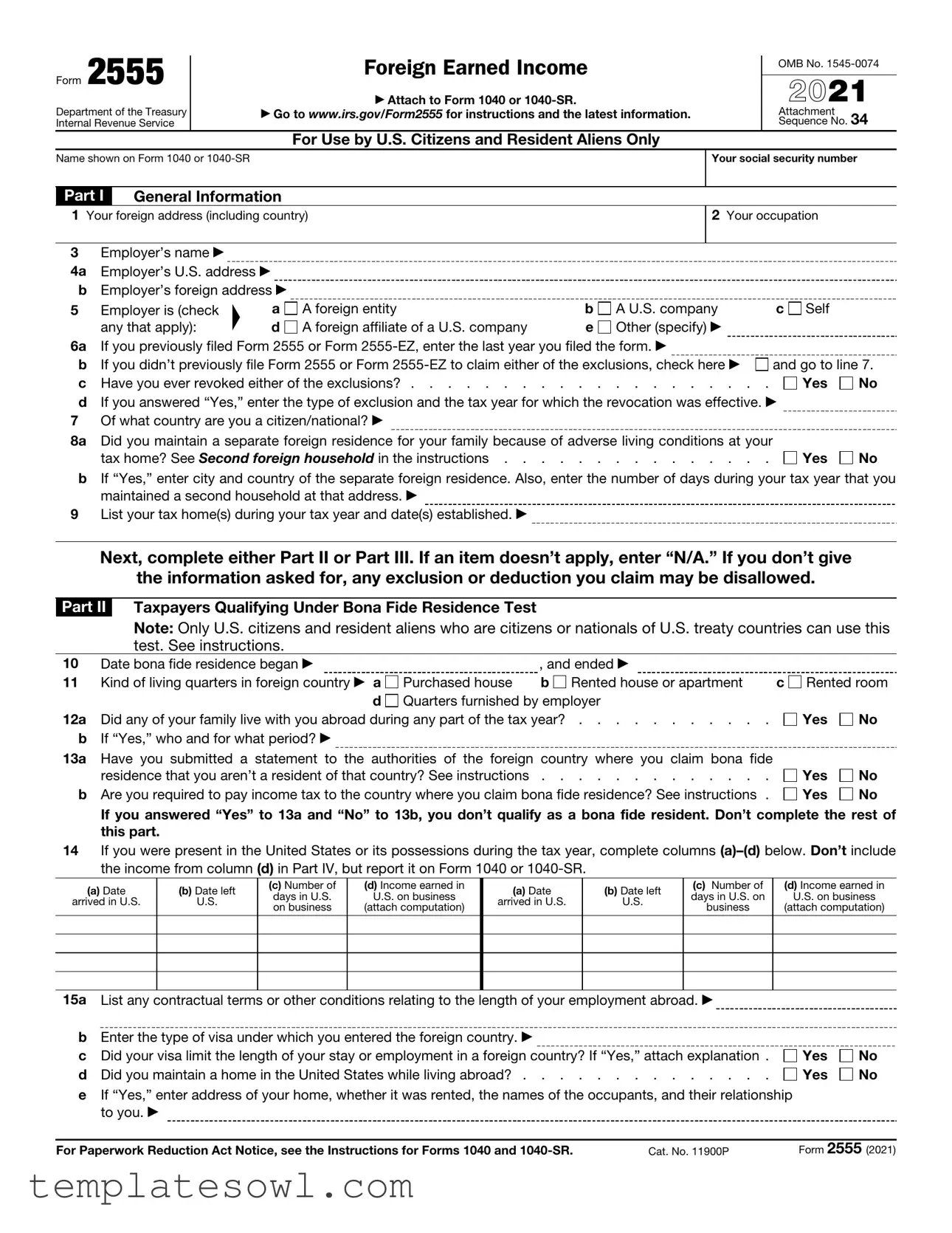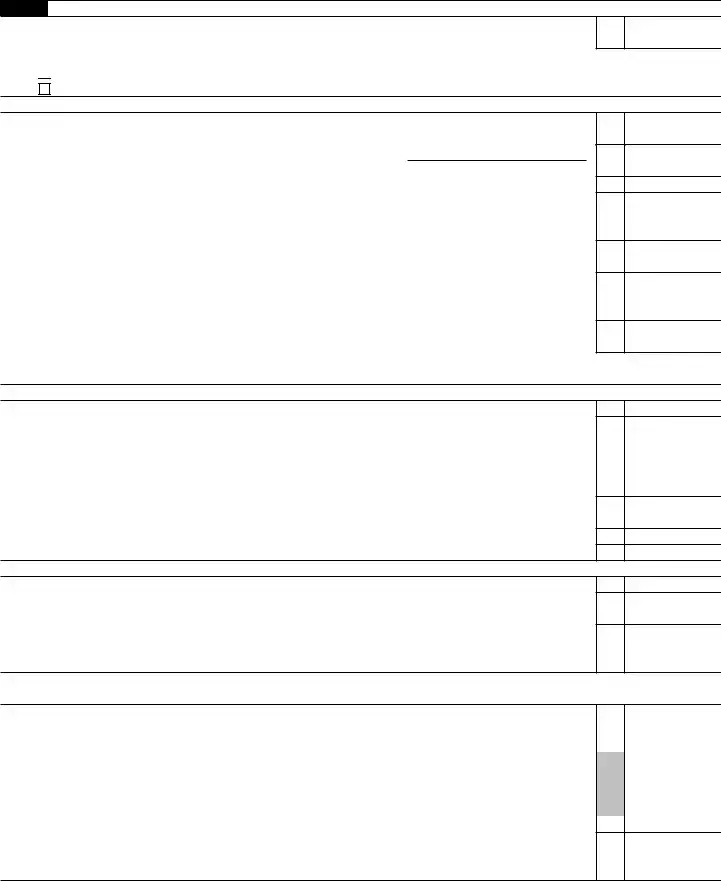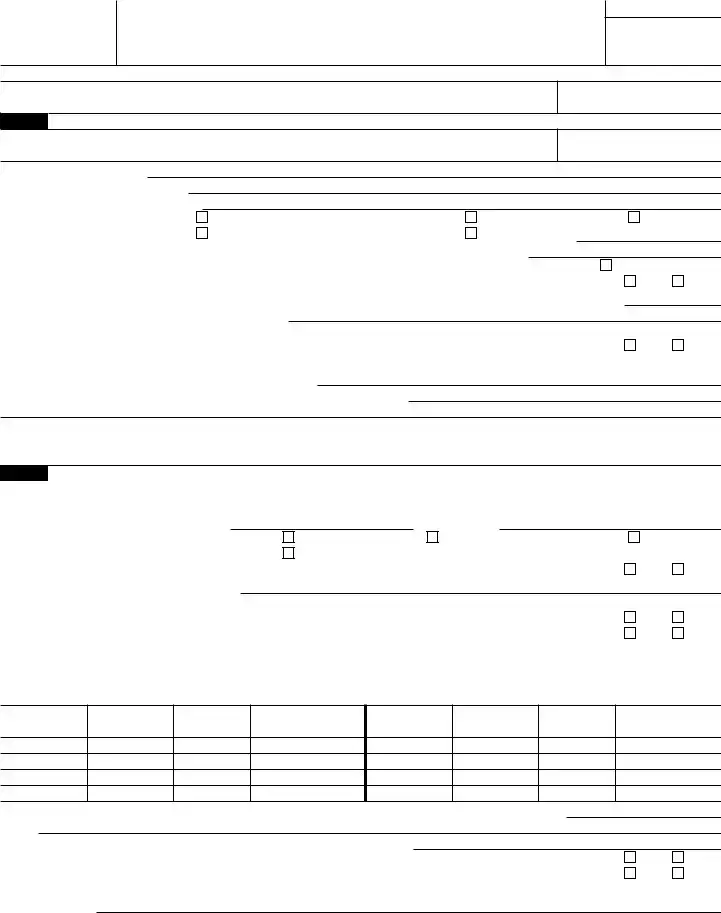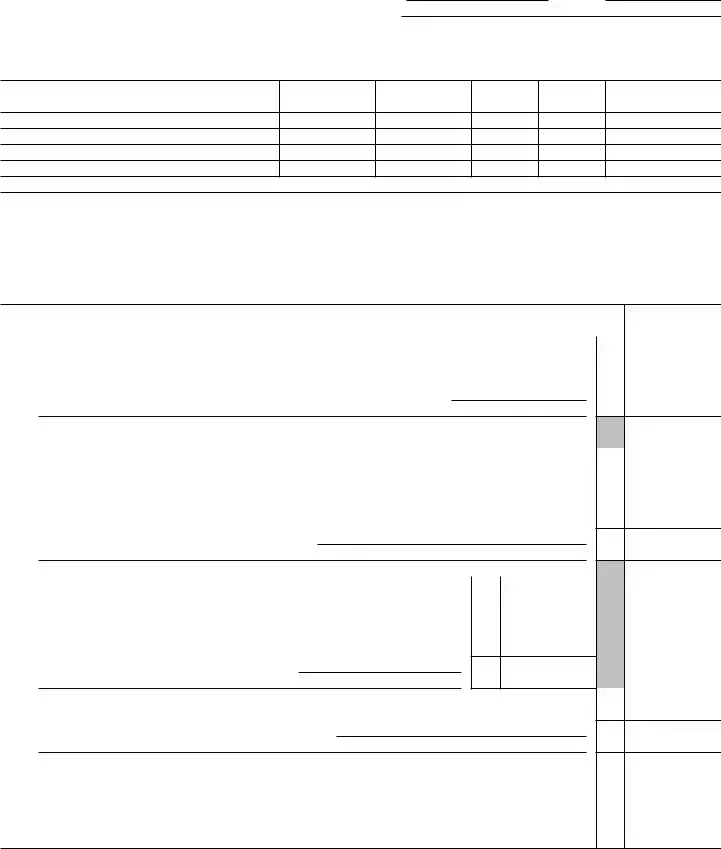Form 2555
Department of the Treasury Internal Revenue Service
Foreign Earned Income
▶Attach to Form 1040 or 1040-SR.
▶Go to www.irs.gov/Form2555 for instructions and the latest information.
For Use by U.S. Citizens and Resident Aliens Only
OMB No. 1545-0074
2021
Attachment 34 Sequence No.
Name shown on Form 1040 or 1040-SR
Part I General Information
1Your foreign address (including country)
Your social security number
2Your occupation
3
4a b 5
6a b c d 7 8a
b
9
Employer’s name ▶ |
|
|
|
|
|
|
|
Employer’s U.S. address ▶ |
|
|
|
|
|
|
Employer’s foreign address ▶ |
|
|
|
|
|
Employer is (check |
▲ |
a |
A foreign entity |
b |
A U.S. company |
c Self |
|
any that apply): |
d |
A foreign affiliate of a U.S. company |
e |
Other (specify) ▶ |
|
|
If you previously filed Form 2555 or Form 2555-EZ, enter the last year you filed the form. ▶ |
|
|
If you didn’t previously file Form 2555 or Form 2555-EZ to claim either of the exclusions, check here ▶ |
and go to line 7. |
Have you ever revoked either of the exclusions? |
Yes |
No |
If you answered “Yes,” enter the type of exclusion and the tax year for which the revocation was effective. ▶ |
|
Of what country are you a citizen/national? ▶ |
|
|
|
|
Did you maintain a separate foreign residence for your family because of adverse living conditions at your |
|
|
tax home? See Second foreign household in the instructions |
Yes |
No |
If “Yes,” enter city and country of the separate foreign residence. Also, enter the number of days during your tax year that you maintained a second household at that address. ▶
List your tax home(s) during your tax year and date(s) established. ▶
Next, complete either Part II or Part III. If an item doesn’t apply, enter “N/A.” If you don’t give
the information asked for, any exclusion or deduction you claim may be disallowed.
Part II Taxpayers Qualifying Under Bona Fide Residence Test
Note: Only U.S. citizens and resident aliens who are citizens or nationals of U.S. treaty countries can use this test. See instructions.
10 |
Date bona fide residence began ▶ |
, and ended ▶ |
|
|
|
11 |
Kind of living quarters in foreign country ▶ a Purchased house |
b Rented house or apartment |
c |
Rented room |
|
d Quarters furnished by employer |
|
|
|
12a |
Did any of your family live with you abroad during any part of the tax year? |
|
Yes |
No |
bIf “Yes,” who and for what period? ▶
13a Have you submitted a statement to the authorities of the foreign country where you claim bona fide |
|
|
residence that you aren’t a resident of that country? See instructions |
Yes |
No |
b Are you required to pay income tax to the country where you claim bona fide residence? See instructions . |
Yes |
No |
If you answered “Yes” to 13a and “No” to 13b, you don’t qualify as a bona fide resident. Don’t complete the rest of this part.
14If you were present in the United States or its possessions during the tax year, complete columns (a)–(d) below. Don’t include the income from column (d) in Part IV, but report it on Form 1040 or 1040-SR.
(c)Number of days in U.S. on business
(d)Income earned in U.S. on business
(attach computation)
(c)Number of days in U.S. on
business
(d)Income earned in U.S. on business
(attach computation)
15a |
List any contractual terms or other conditions relating to the length of your employment abroad. ▶ |
|
|
b Enter the type of visa under which you entered the foreign country. ▶ |
|
|
c |
Did your visa limit the length of your stay or employment in a foreign country? If “Yes,” attach explanation . |
Yes |
No |
d |
Did you maintain a home in the United States while living abroad? |
Yes |
No |
eIf “Yes,” enter address of your home, whether it was rented, the names of the occupants, and their relationship to you. ▶
For Paperwork Reduction Act Notice, see the Instructions for Forms 1040 and 1040-SR. |
Cat. No. 11900P |
Form 2555 (2021) |
Form 2555 (2021) |
Page 2 |
Part III |
Taxpayers Qualifying Under Physical Presence Test |
|
|
Note: U.S. citizens and all resident aliens can use this test. See instructions. |
|
16 The physical presence test is based on the 12-month period from ▶ |
through ▶ |
17Enter your principal country of employment during your tax year. ▶
18If you traveled abroad during the 12-month period entered on line 16, complete columns (a)–(f) below. Exclude travel between foreign countries that didn’t involve travel on or over international waters, or in or over the United States, for 24 hours or more. If you have no travel to report during the period, enter “Physically present in a foreign country or countries for the entire 12- month period.” Don’t include the income from column (f) below in Part IV, but report it on Form 1040 or 1040-SR.
|
(a) Name of country |
(b) Date arrived |
(c) Date left |
(d) Full days |
(e) Number of |
(f) Income earned in U.S. |
|
present in |
days in U.S. |
on business (attach |
|
(including U.S.) |
|
|
|
country |
on business |
computation) |
|
|
|
|
Part IV All Taxpayers
Note: Enter on lines 19 through 23 all income, including noncash income, you earned and actually or constructively received during your 2021 tax year for services you performed in a foreign country. If any of the foreign earned income received this tax year was earned in a prior tax year, or will be earned in a later tax year (such as a bonus), see the instructions. Don’t include income from line 14, column (d), or line 18, column (f). Report amounts in U.S. dollars, using the exchange rates in effect when you actually or constructively received the income.
If you are a cash basis taxpayer, report on Form 1040 or 1040-SR all income you received in 2021, no matter when you performed the service.
|
2021 Foreign Earned Income |
Amount |
|
(in U.S. dollars) |
|
|
|
|
|
19 |
Total wages, salaries, bonuses, commissions, etc |
19 |
20 |
Allowable share of income for personal services performed (see instructions): |
|
a |
In a business (including farming) or profession |
20a |
b In a partnership. List partnership’s name and address and type of income. ▶ |
|
|
|
20b |
21Noncash income (market value of property or facilities furnished by employer—attach statement showing how it was determined):
a |
Home (lodging) |
21a |
b |
Meals |
21b |
c |
Car |
21c |
dOther property or facilities. List type and amount. ▶
21d
22Allowances, reimbursements, or expenses paid on your behalf for services you performed:
a |
Cost of living and overseas differential |
22a |
b |
Family |
22b |
c |
Education |
22c |
d |
Home leave |
22d |
e |
Quarters |
22e |
fFor any other purpose. List type and amount. ▶
22f
g Add lines 22a through 22f . . . . . . . . . . . . . . . . . . . . . . . . . 22g
23Other foreign earned income. List type and amount. ▶
23
24 |
Add lines 19 through 21d, line 22g, and line 23 |
24 |
25 |
Total amount of meals and lodging included on line 24 that is excludable (see instructions) . . . . |
25 |
26 |
Subtract line 25 from line 24. Enter the result here and on line 27 on page 3. This is your 2021 foreign |
|
|
earned income . . . . . . . . . . . . . . . . . . . . . . . . . . . . ▶ |
26 |
Form 2555 (2021)
27 Enter the amount from line 26 . . . . . . . . . . . . . . . . . . . . . . . .
Are you claiming the housing exclusion or housing deduction? 
 Yes. Complete Part VI.
Yes. Complete Part VI.
No. Go to Part VII.
Part VI Taxpayers Claiming the Housing Exclusion and/or Deduction
28 |
Qualified housing expenses for the tax year (see instructions) |
28 |
29a |
Enter location where housing expenses incurred. See instructions. ▶ |
|
|
|
b |
Enter limit on housing expenses. See instructions |
29b |
30 |
Enter the smaller of line 28 or line 29b |
30 |
31 |
Number of days in your qualifying period that fall within your 2021 tax year |
|
|
|
|
(see instructions) |
31 |
days |
|
32 |
Multiply $47.65 by the number of days on line 31. If 365 is entered on line 31, enter $17,392 here . . |
32 |
33Subtract line 32 from line 30. If the result is zero or less, don’t complete the rest of this part or any of
|
Part IX |
. . . . . . . |
33 |
34 |
Enter employer-provided amounts. See instructions |
34 |
|
|
35Divide line 34 by line 27. Enter the result as a decimal (rounded to at least three places), but don’t
enter more than “1.000” |
35 |
36Housing exclusion. Multiply line 33 by line 35. Enter the result but don’t enter more than the amount
on line 34. Also, complete Part VIII . . . . . . . . . . . . . . . . . . . . . ▶ |
36 |
Note: The housing deduction is figured in Part IX. If you choose to claim the foreign earned income exclusion, complete Parts VII and VIII before Part IX.
Part VII Taxpayers Claiming the Foreign Earned Income Exclusion
37 |
Maximum foreign earned income exclusion. Enter $108,700 |
. |
37 |
38 |
• If you completed Part VI, enter the number from line 31. |
} |
|
|
|
|
|
• All others, enter the number of days in your qualifying period that fall |
38 |
days |
|
|
within your 2021 tax year. See the instructions for line 31. |
|
|
|
|
39 |
• If line 38 and the number of days in your 2021 tax year (usually 365) are the same, enter “1.000.” |
} |
|
|
• Otherwise, divide line 38 by the number of days in your 2021 tax year and enter the result as a |
39 |
|
decimal (rounded to at least three places). |
|
|
|
|
40 |
Multiply line 37 by line 39 |
. |
40 |
41 |
Subtract line 36 from line 27 |
. |
41 |
42 |
Foreign earned income exclusion. Enter the smaller of line 40 or line 41. Also, complete Part VIII . . |
▶ |
42 |
Part VIII Taxpayers Claiming the Housing Exclusion, Foreign Earned Income Exclusion, or Both
43 Add lines 36 and 42 . . . . . . . . . . . . . . . . . . . . . . . . . . .
44Deductions allowed in figuring your adjusted gross income (Form 1040 or 1040-SR, line 11) that are allocable to the excluded income. See instructions and attach computation . . . . . . . . .
45Subtract line 44 from line 43. Enter the result here and in parentheses on Schedule 1 (Form 1040), line 8d. Complete the Foreign Earned Income Tax Worksheet in the Instructions for Forms 1040 and
1040-SR if you enter an amount on this line . . . . . . . . . . . . . . . . . . .
Part IX Taxpayers Claiming the Housing Deduction—Complete this part only if (a) line 33 is more than line 36, and
(b)line 27 is more than line 43.
46 |
Subtract line 36 from line 33 |
46 |
47 |
Subtract line 43 from line 27 |
47 |
48 |
Enter the smaller of line 46 or line 47 |
48 |
|
Note: If line 47 is more than line 48 and you couldn’t deduct all of your 2020 housing deduction |
|
|
because of the 2020 limit, use the Housing Deduction Carryover Worksheet in the instructions to |
|
|
figure the amount to enter on line 49. Otherwise, go to line 50. |
|
49Housing deduction carryover from 2020 (from the Housing Deduction Carryover Worksheet in the
50Housing deduction. Add lines 48 and 49. Enter the total here and on Schedule 1 (Form 1040), line 24j. Complete the Foreign Earned Income Tax Worksheet in the Instructions for Forms 1040 and
1040-SR if you enter an amount on this line . . . . . . . . . . . . . . . . . . . ▶ |
50 |
Form 2555 (2021)





